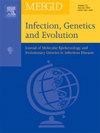伊朗西部地区布鲁氏菌病疑似患者血清中布氏柯谢氏菌的流行病学和分子调查
IF 2.6
4区 医学
Q3 INFECTIOUS DISEASES
引用次数: 0
摘要
Q 热是一种影响人类和动物的全球性细菌性疾病。该病的病原体是烧伤克氏菌。调查的目的是检测伊朗西部有发热症状并怀疑患有布鲁氏菌病的患者血清样本中是否存在烧伤克氏菌。在本次调查中,2023 年从洛雷斯坦省、哈马丹省、伊拉姆省、克尔曼沙阿省和库尔德斯坦省的医疗中心收集了 150 份赖特凝集试验样本。所有这些样本都是从疑似布鲁氏菌病患者身上提取的 DNA。然后,利用巢式 PCR 反应对转座子基因 IS1111 进行诊断。IS1111基因复制检测结果显示,3.3%(95% CI:1.43%-3.33%)的受检血清样本对布鲁氏菌呈阳性反应。库尔德斯坦省的烧伤桿菌感染率最高,为 6.67 %(95 % CI:1.85 %-21.33 %)。此外,本研究中测序的 IS1111 基因与来自世界各地的 IS1111 基因之间具有很高的亲和性(从 99 % 到 100 % 不等)。这些结果有力地证明,伊朗西部的布鲁氏菌病患者也可能同时感染了烧伤桿菌和柯西氏菌病。因此,将 Q 热视为布鲁氏菌病疑似患者的合并感染非常重要。本文章由计算机程序翻译,如有差异,请以英文原文为准。
Epidemiological and molecular survey of Coxiella burnetii from the serum of patients suspected of brucellosis in west of Iran
Q fever is a global bacterial disease that affects both humans and animals. The etiological agent of the disease is Coxiella burnetii. The aim of the investigation was to detect the existence of C. burneti in the serum samples of patients with symptoms of fever and suspicion of brucellosis in the west of Iran. In the current survey, 150 Wright agglutination assay were collected from health centers in Lorestan, Hamadan, Ilam, Kermanshah, and Kurdistan provinces in 2023. DNA was extracted from all these samples, which were taken from individuals suspected of having brucellosis. Then, a nested PCR reaction was applied to diagnose C. burnetii for the transposon gene IS1111. The IS1111 gene replication assays, indicated that 3.3 % (95 % CI: 1.43 %–3.33 %) of the tested serum samples, were positive for C. burnetii. The highest prevalence of C. burnetii infection was found in the Kurdistan province at 6.67 % (95 % CI: 1.85 %–21.33 %). Additionally, a high affinity (ranging from 99 % to 100 %) was recognized among the IS1111 gene sequenced in the present study and those from different area around the world. These results provide strong evidence that individuals with brucellosis in west of Iran may also have C. burnetii co-infection with coxiellosis. Therefore, it is important to consider Q fever as a co-infection in patients suspected of brucellosis.
求助全文
通过发布文献求助,成功后即可免费获取论文全文。
去求助
来源期刊

Infection Genetics and Evolution
医学-传染病学
CiteScore
8.40
自引率
0.00%
发文量
215
审稿时长
82 days
期刊介绍:
(aka Journal of Molecular Epidemiology and Evolutionary Genetics of Infectious Diseases -- MEEGID)
Infectious diseases constitute one of the main challenges to medical science in the coming century. The impressive development of molecular megatechnologies and of bioinformatics have greatly increased our knowledge of the evolution, transmission and pathogenicity of infectious diseases. Research has shown that host susceptibility to many infectious diseases has a genetic basis. Furthermore, much is now known on the molecular epidemiology, evolution and virulence of pathogenic agents, as well as their resistance to drugs, vaccines, and antibiotics. Equally, research on the genetics of disease vectors has greatly improved our understanding of their systematics, has increased our capacity to identify target populations for control or intervention, and has provided detailed information on the mechanisms of insecticide resistance.
However, the genetics and evolutionary biology of hosts, pathogens and vectors have tended to develop as three separate fields of research. This artificial compartmentalisation is of concern due to our growing appreciation of the strong co-evolutionary interactions among hosts, pathogens and vectors.
Infection, Genetics and Evolution and its companion congress [MEEGID](http://www.meegidconference.com/) (for Molecular Epidemiology and Evolutionary Genetics of Infectious Diseases) are the main forum acting for the cross-fertilization between evolutionary science and biomedical research on infectious diseases.
Infection, Genetics and Evolution is the only journal that welcomes articles dealing with the genetics and evolutionary biology of hosts, pathogens and vectors, and coevolution processes among them in relation to infection and disease manifestation. All infectious models enter the scope of the journal, including pathogens of humans, animals and plants, either parasites, fungi, bacteria, viruses or prions. The journal welcomes articles dealing with genetics, population genetics, genomics, postgenomics, gene expression, evolutionary biology, population dynamics, mathematical modeling and bioinformatics. We also provide many author benefits, such as free PDFs, a liberal copyright policy, special discounts on Elsevier publications and much more. Please click here for more information on our author services .
 求助内容:
求助内容: 应助结果提醒方式:
应助结果提醒方式:


